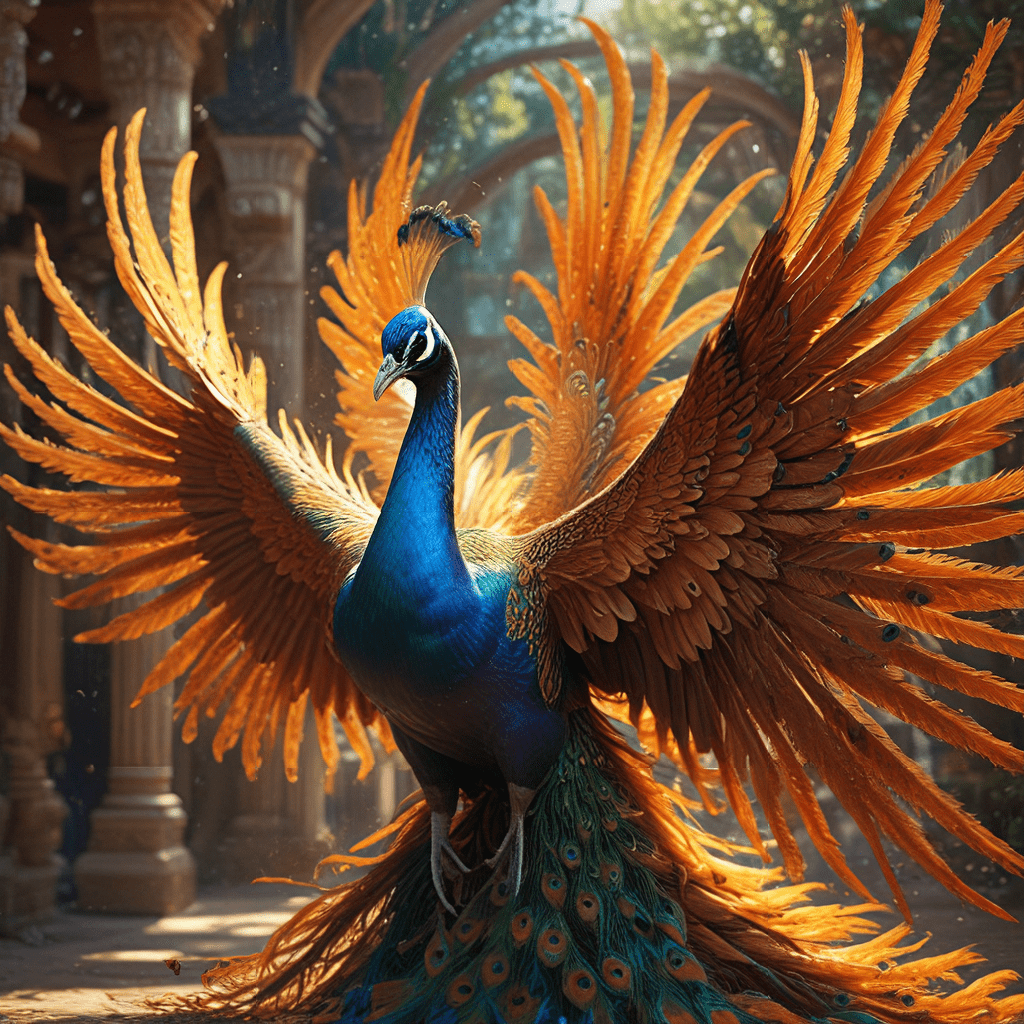The Phoenix and the Peacock: The Symbol of Beauty, Magnificence, and the Spirit of Transformation
The Phoenix: Rebirth and Immortality
The phoenix, a legendary bird, is a potent symbol of rebirth, immortality, and the cyclical nature of life. Across cultures, the phoenix is depicted as a magnificent creature, often with brilliant red or gold plumage, rising from its own ashes. This cycle of death and resurrection represents the continuous renewal of life and the triumph of hope over despair.
This mythical bird’s story is found in various ancient cultures, with each variation adding its own unique interpretation. In ancient Egypt, the phoenix was associated with the sun god Ra, symbolizing the daily resurrection of the sun. This association with the sun and its rebirth every morning further reinforces the phoenix’s connection to cyclical time and immortality.
The phoenix’s story resonates across civilizations due to its powerful message of hope and renewal. It suggests that even in the face of destruction, life can be reborn, and a new beginning is always possible. This enduring message of resilience and hope has made the phoenix a potent symbol throughout history.
The Peacock: Pride, Beauty, and Divine Connection
The peacock, with its stunning iridescent plumage and elaborate courtship displays, is a symbol of beauty, pride, and divine connection. Its striking blue, green, and gold feathers, resembling a thousand eyes, have captivated cultures across the globe, making it a revered creature in art, literature, and mythology.
The peacock’s elaborate plumage is often associated with pride, a quality both admired and feared. Its majestic displays, where it unfurls its feathers to attract a mate, are a spectacle of beauty and confidence. However, its pride can also be seen as a symbol of vanity or arrogance, highlighting the double-edged nature of this powerful emotion.
Beyond its earthly beauty, the peacock holds a spiritual significance in many cultures. In Hinduism, the peacock is the vehicle of Saraswati, the goddess of knowledge, music, and the arts. This connection elevates the peacock to a symbol of wisdom, creativity, and divine inspiration. Its presence is often seen as a sign of good fortune and prosperity.
Shared Themes: Beauty and Transformation
Both the phoenix and the peacock, despite their contrasting appearances and symbolism, share a common thread: their association with beauty and transformation. They embody the power of renewal, whether through the phoenix’s fiery resurrection or the peacock’s symbolic association with divine grace and wisdom.
The phoenix, rising from ashes, embodies the beauty of rebirth and the triumph of spirit over adversity. It reminds us that even in the darkest of times, hope and renewal are always possible. The peacock, with its radiant plumage and symbolic connection to the divine, embodies the beauty of transformation, showcasing the potential for growth and evolution within every being.
By exploring these shared themes, we can gain a deeper understanding of the enduring power of these mythical creatures. Their symbolism transcends cultural boundaries, reminding us of the transformative power of beauty and the eternal cycle of life, death, and rebirth.
The Phoenix: A Symbol of Renewal and Cyclical Time
The phoenix, as a symbol of renewal, is intimately connected to the concept of cyclical time. Its fiery rebirth represents the natural cycle of decay and renewal, present in all aspects of existence. From the seasons changing to the growth and decay of plants, nature constantly cycles, and the phoenix mirrors this natural process.
This cyclical nature extends beyond the natural world. The phoenix’s story suggests that human life also follows a similar pattern of growth, decline, and rebirth. It reminds us that endings are not always the end, but rather transitions into new beginnings. This understanding of cyclical time encourages us to embrace change, accept the inevitability of endings, and find hope in the promise of new beginnings.
The phoenix’s ability to rise from ashes speaks to the resilience of life and the constant possibility of renewal. It reminds us that we too can overcome adversity, transform our pain into growth, and emerge stronger from challenging experiences. This message of resilience and renewal is particularly powerful in times of personal struggle or societal upheaval.
The Peacock: A Representation of Pride and Majesty
The peacock’s striking plumage and elaborate displays are often associated with pride, a complex emotion that can inspire both admiration and caution. The peacock’s pride is not simply vanity or arrogance; it is a representation of confidence, self-awareness, and the willingness to stand out from the crowd.
Its willingness to display its beauty and attract attention highlights the importance of self-expression and embracing one’s individuality. The peacock’s boldness encourages us to be proud of our unique qualities and to express ourselves authentically, even when it means standing out or facing criticism.
However, the peacock’s pride can also serve as a cautionary tale. Its unwavering confidence can sometimes border on arrogance, reminding us that pride can be both a source of strength and a potential downfall. It encourages us to be mindful of the balance between confidence and humility, recognizing that true strength lies in both self-assurance and the ability to learn from others.
The peacock’s majestic presence also symbolizes royalty and nobility. Its association with divine beings, like Saraswati, elevates it beyond a mere bird, making it a symbol of spiritual grace and elevated consciousness. The peacock’s beauty reminds us that there is a divine spark within each of us, and that we are capable of achieving great things when we embrace our true potential.
The Phoenix and the Peacock in Mythology and Folklore
The phoenix and the peacock have graced myths and legends across cultures, each story adding a unique layer to their symbolic significance.
From the ancient civilizations of Egypt to the rich tapestry of Indian mythology, these creatures are interwoven into the fabric of cultural beliefs. Their enduring presence in folklore speaks to their universal appeal and the timeless themes they embody.
In Egyptian mythology, the phoenix, known as the Bennu bird, was associated with the sun god Ra. It represented the cyclical nature of the sun, rising each morning and setting each evening, symbolizing rebirth and renewal. The Bennu bird was also believed to have the ability to live for hundreds of years before burning itself on a pyre and rising again from its ashes, providing a powerful metaphor for the eternal cycle of life, death, and rebirth.
In Greek mythology, the phoenix was said to inhabit Arabia and had a lifespan of 500 years. Upon reaching the end of its life, it would build a nest of fragrant wood and set itself ablaze. From the ashes, a new phoenix would rise, symbolizing the triumph of life over death and the enduring nature of hope.
Similarly, the peacock has a rich history in various cultures. In ancient Greece, the peacock was associated with Hera, the goddess of marriage and women. Its iridescent plumage was seen as a symbol of beauty and fertility. In India, the peacock is deeply revered as the vehicle of Saraswati, the goddess of knowledge, music, and the arts. Its presence is often associated with wisdom, creativity, and divine inspiration. It is said that the Goddess Saraswati uses the peacock’s feathers as a brush to paint the universe, highlighting the peacock’s connection to art and creation.
The stories surrounding these mythical creatures reveal their profound influence on human imagination and the enduring power of symbolism. They offer a glimpse into the hopes, fears, and beliefs of the cultures that embraced them, and continue to inspire wonder and fascination today.
The Phoenix in Ancient Egypt: The Benben and the Solar Cycle
The phoenix, known as the Bennu bird in ancient Egypt, held a prominent place in their mythology and was deeply linked to the solar cycle and the concept of rebirth. The Bennu was often depicted as a heron with white and gold plumage, symbolizing the brilliance of the sun.
The association with the sun is not just a symbolic one. The Bennu was also linked to the Benben stone, a sacred pyramidal stone that was believed to have emerged from the primordial waters and represented the first landmass in the world. The Benben stone was also associated with the rising sun, its pointed shape resembling the sun’s rays.
The Bennu bird was believed to have emerged from the Benben stone, further solidifying its association with creation and rebirth. This connection linked the Bennu to the cyclical nature of the sun, rising and setting each day, representing the eternal cycle of life, death, and rebirth.
The Egyptians believed that the Bennu bird lived for hundreds of years before setting itself ablaze on a pyre, only to rise again from the ashes, mirroring the daily rebirth of the sun. This cyclical nature, tied to the sun and the creation of the world, made the Bennu a significant symbol of immortality and renewal in ancient Egyptian culture.
The Peacock in Indian Mythology: The Vehicle of the Goddess Saraswati
In Indian mythology, the peacock holds a revered position as the vehicle of Saraswati, the goddess of knowledge, music, art, and wisdom. This association elevates the peacock beyond mere earthly beauty and connects it with divine grace and creativity.
The peacock, with its iridescent plumage, symbolizes the beauty and brilliance of Saraswati’s wisdom. It is said that the Goddess uses the peacock’s feathers as a brush to paint the universe, showcasing its connection to art, creation, and the power of imagination.
The peacock’s presence is often associated with good fortune and prosperity, as Saraswati is worshipped for her blessings of knowledge, learning, and creativity. It is believed that offering prayers to Saraswati, riding on her peacock, can bring success and fulfillment in artistic endeavors and academic pursuits.
The peacock’s connection to Saraswati also highlights a deeper philosophical concept: the interconnectedness of knowledge, beauty, and creativity. The peacock’s beauty, its connection to the goddess of knowledge, and its symbolic association with art, creation, and inspiration emphasizes the profound link between knowledge, beauty, and the human spirit.
The Phoenix and the Peacock in Art and Literature
The phoenix and the peacock have inspired artists and writers across cultures and time periods, leaving an indelible mark on the artistic landscape. Their captivating imagery and symbolic significance have been interpreted in various forms, becoming enduring figures in art and literature.
In visual art, the phoenix is often depicted rising from a pyre, its fiery wings spread wide, symbolizing rebirth, hope, and the triumph of spirit over adversity. Its fiery plumage and the contrast of darkness and light create a powerful visual metaphor for transformation and renewal.
The peacock, with its stunning iridescent feathers, has captivated artists with its beauty and symbolic connection to divinity. Its intricate plumage has been incorporated into paintings, sculptures, and decorative motifs, often highlighting its connection to Saraswati and the divine feminine.
In literature, the phoenix and the peacock have also played significant roles, serving as metaphors and symbols in diverse narratives. In Western literature, the phoenix is often used to represent the cyclical nature of life, death, and rebirth, appearing in works as diverse as the writings of Ovid and the works of J.K. Rowling.
In Indian literature, the peacock’s association with Saraswati has inspired countless tales and poems, highlighting its connection to knowledge, creativity, and the divine. Its presence is often interpreted as a symbol of beauty, grace, and the power of imagination.
The enduring presence of the phoenix and the peacock in art and literature speaks to their timeless appeal and their ability to transcend cultural boundaries. These mythical creatures continue to inspire artists and writers, offering a rich tapestry of symbolism and a compelling exploration of human hopes and aspirations.
The Enduring Legacy of the Phoenix and the Peacock
The phoenix and the peacock, despite their different origins and symbolism, share a common thread: their enduring legacy as potent symbols of beauty, transformation, and the power of the human spirit. Their stories, steeped in mythology and folklore, continue to inspire and captivate audiences across cultures and generations.
The phoenix’s ability to rise from ashes embodies the resilience of life and the continuous possibility of renewal. It is a symbol of hope, reminding us that even in the face of adversity, we can emerge stronger and find new beginnings. Its fiery rebirth speaks to the cyclical nature of existence, highlighting the constant interplay between death and renewal.
The peacock, with its stunning plumage and symbolic connection to divine grace and wisdom, embodies beauty, pride, and the transformative power of imagination. Its association with Saraswati, the goddess of knowledge and creativity, inspires us to embrace our potential and cultivate our artistic and intellectual gifts. It reminds us that within each of us lies a spark of divinity, capable of creating beauty and illuminating the world with our unique talents.
The phoenix and the peacock, through their enduring presence in mythology, art, and literature, serve as powerful reminders of the transformative power of the human spirit. They inspire us to embrace change, find hope in the face of adversity, and strive for beauty and wisdom in our lives.
## FAQ
**What is the difference between a phoenix and a peacock?**
The phoenix is a legendary bird known for its ability to rise from its own ashes, symbolizing rebirth and immortality. The peacock is a real bird known for its stunning iridescent plumage, often associated with pride, beauty, and the divine feminine.
**What does the phoenix symbolize?**
The phoenix symbolizes rebirth, immortality, renewal, and the cyclical nature of life.
**What does the peacock symbolize?**
The peacock symbolizes pride, beauty, divine connection, knowledge, art, and creation.
**Where does the phoenix come from?**
The phoenix is found in ancient myths and legends across cultures, including Egypt, Greece, and China.
**Where does the peacock come from?**
Peacocks are native to South Asia, but have been introduced to other parts of the world.
**What is the significance of the phoenix in ancient Egypt?**
In ancient Egypt, the phoenix, known as the Bennu bird, was associated with the sun god Ra and represented the cyclical nature of the sun, rising and setting each day.
**What is the significance of the peacock in Indian mythology?**
In Indian mythology, the peacock is the vehicle of Saraswati, the goddess of knowledge, music, art, and wisdom. It symbolizes beauty, grace, and divine inspiration.



